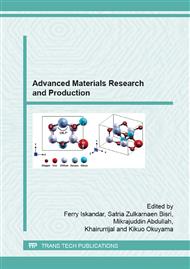[1]
A.N. Marquez, R. Romero, A. Romeroa and J.L. Valverde, J. Mater. Chem 21 (2011) 1664–1672.
Google Scholar
[2]
T. W. Ebbesen, P. M. Ajayan (1992). Large-Scale Synthesis of Carbon Nanotubes, Nature 358 (1992) 220-222.
DOI: 10.1038/358220a0
Google Scholar
[3]
A. Thess, R. Lee, P. Nikolaev, H. Dai, P. Petit, J. Robert, C. Xu, Y. H. Lee, S. G. Kim, A. G. Rinzler, D. T. Colbert, G. E. Scuseria, D. Tomanek, J. Fischer, R. E. Smalley, Crystalline Ropes of Metallic Carbon Nanotubes, Science 273 (1996).
DOI: 10.1126/science.273.5274.483
Google Scholar
[4]
Al. Darabont, P. Nemes-Incze, K. Kertész, L. Tapasztó , A. A. Koós , Z. Osváth , Zs. Sárközi, Z. Vértesy , Z. E. Horváth , L. P. Biró, Synthesis of Carbon Nanotubes by Spray Pyrolysis and Their Investigation by Electron Microscopy, J. Optoelectron. Adv. Mater., 7 (2005).
DOI: 10.1016/j.carbon.2004.11.048
Google Scholar
[5]
Y. Hayashi, T. Negishi, S. Nishino, Growth of Well-Aligned Carbon Nanotubes on Nickel by Hot-Filament-Assisted DC Plasma Chemical Vapor Deposition in a CH4/H2 Plasma, J. Vac. Sci. Technol., A 19 (2001) 1796-1799.
DOI: 10.1116/1.1345903
Google Scholar
[6]
K. B. K. Teo, M. Chhowalla, G. A. J. Amaratunga, W. I. Milne, G. Pirio, P. Legagneux, D. Pribat, D. Hasko, Field Emission from Dense, Sparse, and Patterned Arrays of Carbon Nanofibers, Appl. Phys. Lett., 80 (2002) 2011-(2013).
DOI: 10.1063/1.1461868
Google Scholar
[7]
Y. Shiratori, H. Hiraoka, Y. Takeuchi, S. Itoh, M. Yamamoto , One-Step Formation of Aligned Carbon Nanotube Field Emitters at 400°C, Appl. Phys. Lett., 82 (2003) 2485-2487.
DOI: 10.1063/1.1566803
Google Scholar
[8]
V.G. Pol, M. Motiei, A. Gedanken, J. Calderon-Moreno, M. Yoshimura, Carbon Spherules: Synthesis, Properties and Mechanistic Elucidation. Carbon 42 (2004), 111.
DOI: 10.1016/j.carbon.2003.10.005
Google Scholar
[9]
N. Wang, D. Yao, Nucleation and Growth of Well-Aligned, Uniform-Sized Carbon Nanotubes by Microwave Plasma Chemical Vapor Depositon, Appl. Phys. Lett., 78 (2001) 4028-4030.
DOI: 10.1063/1.1381036
Google Scholar
[10]
Q. Wang, H. Li, L. Chen, X. Huang, Monodispersed Hard Carbon Spherules with Uniform Nanopores. Carbon 39( 2001) 2211.
DOI: 10.1016/s0008-6223(01)00040-9
Google Scholar


